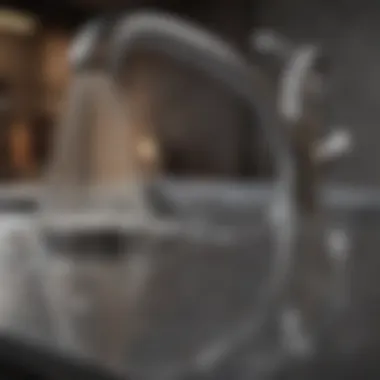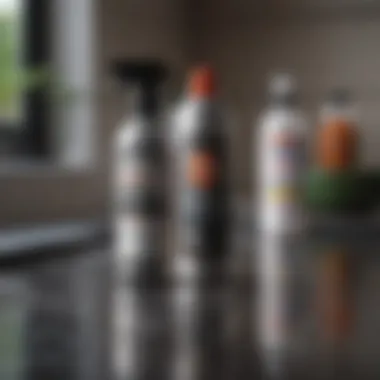Effective DIY Stainless Steel Cleaner Alternatives


Intro
Cleaning stainless steel can be quite a challenge. Traditional methods often rely on vinegar, yet many people seek alternatives for various reasons. This article aims to explore effective DIY stainless steel cleaning solutions that do not involve vinegar. Understanding the chemical properties of stainless steel and how certain household items can be utilized is crucial. By analyzing various cleaning methods, we will uncover advantages as well as potential downsides of these alternatives.
Homeowners and design enthusiasts alike can benefit from this guide, ensuring their appliances and fixtures remain visually appealing. The insights provided here will not only help maintain that sleek look but also promote a deeper understanding of the materials we often take for granted in our lives.
Understanding Stainless Steel
Understanding stainless steel is essential for maintaining its appearance and longevity. This section provides insights into its composition, common uses, and maintenance challenges. Such knowledge empowers homeowners and design enthusiasts to make informed cleaning choices, ensuring that stainless steel surfaces retain their luster and durability.
Composition and Properties
Stainless steel is an alloy primarily composed of iron, chromium, and nickel. The chromium content, usually 10.5% or more, is crucial as it forms a thin, invisible layer of chromium oxide when exposed to oxygen. This layer protects the underlying steel from rust and corrosion, making stainless steel a favored material for various applications.
Besides its corrosion resistance, stainless steel is known for its strength and formability. It can withstand high temperatures and is relatively easy to clean. There are different grades of stainless steel, each tailored for specific uses based on characteristics like strength and appearance. For instance, the 304 grade is often used for kitchen appliances due to its excellent resistance to oxidation.
Common Uses in Homes
Stainless steel is prevalent in many household fixtures and appliances due to its aesthetic appeal and practicality. Some common applications include:
- Kitchen Appliances: Refrigerators, ovens, and dishwashers often use stainless steel for its sleek look and easy maintenance.
- Sinks and Faucets: Many homeowners prefer stainless steel sinks as they resist staining and are simple to clean.
- Furniture: Stainless steel frames and accents are popular in modern furniture designs, offering a contemporary feel.
This versatility ensures that stainless steel is not just a functional material but also plays a significant role in the aesthetic of homes.
Challenges in Maintenance
While stainless steel is durable, it is not entirely maintenance-free. Some common challenges homeowners face include:
- Scratches and Marks: Even though it is resistant to rust, stainless steel can scratch and show fingerprints. These imperfections can be noticeable on certain finishes.
- Stains from Cleaning Products: Some cleaning agents can leave behind streaks or discoloration. It is crucial to select appropriate cleaning methods to prevent damage.
- Environmental Factors: Humidity and exposure to certain chemicals can lead to tarnishing or discoloration over time.
Being aware of these challenges allows homeowners to take proactive steps in maintaining their stainless steel surfaces effectively.
Why Avoid Vinegar in Cleaning
Cleaning stainless steel surfaces is often a routine task for many households. However, one commonly suggested household cleaner, vinegar, can lead to problems. Understanding the reasons why vinegar should be avoided in this context is crucial for proper maintenance of stainless steel appliances and fixtures.
Vinegar is an acid, and its corrosive nature can negatively affect stainless steel. The chemical properties of stainless steel make it susceptible to damage if exposed to harsh solvents. Therefore, knowing the implications of using vinegar is important for maintaining the integrity and appearance of these surfaces.
Acidity and Its Effects
The acidity of vinegar is a fundamental concern when it comes to cleaning stainless steel. Vinegar has a pH of around 2.5, meaning it is quite acidic. When this liquid is applied to stainless steel, it can result in chemical reactions that may compromise the protective chromium oxide layer on the surface.
This layer is essential for preventing corrosion and maintaining the shine of stainless steel. If it becomes damaged, the metal underneath may be exposed to moisture and oxygen, leading to rust. Additionally, repeated exposure to vinegar can create dull spots or discoloration on the surface.
It is worth noting that some other common cleaning products also contain acids, which can produce similar damaging effects on stainless steel. Thus, using vinegar, while seemingly harmless, can significantly deteriorate the clean appearance of your appliances.
Potential for Damage


Beyond the acidity itself, using vinegar has practical implications that homeowners must consider. Vinegar's potential to cause damage does not stop at the surface level. Prolonged use can lead to irreversible harm, ultimately necessitating costly repairs or replacements. Also, the application methods of vinegar, if not done carefully, can cause scratching and further mar the shiny finish.
Here are some potential damages associated with vinegar use:
- Surface Scratches: If vinegar is not wiped off carefully, it can cause physical scratches.
- Dulling: As mentioned previously, frequent use can dull the shine.
- Corrosion: Over time, even small wounds to the protective layer can lead to larger corrosion issues.
"Using vinegar might seem easy and efficient, but it is often not worth the potential long-term damage it can cause to stainless steel surfaces."
Alternative Cleaning Solutions
Finding effective cleaning solutions for stainless steel without vinegar is crucial for maintaining its appearance and longevity. Vinegar's acidity can lead to detrimental effects on stainless steel surfaces. Therefore, it is essential to explore alternatives that are not only safe but also efficient.
This section delves into various cleaning methods, emphasizing oil-based cleaners, soap and water techniques, and baking soda mixtures. Each of these alternatives offers unique benefits, ensuring that homeowners can select the right solution based on their specific needs and preferences. Understanding these methods can also promote cost-effectiveness and environmental responsibility, essential aspects when it comes to maintaining household cleaning practices.
Oil-Based Cleaners
Oil-based cleaners have gained popularity as effective options for cleaning stainless steel. These cleaners generally leave a protective layer on the surface, enhancing shine while preventing future smudging and fingerprints.
Mineral oil
Mineral oil is a standout choice within the realm of oil-based cleaners. Its non-toxic properties make it suitable for use in kitchen appliances and utensils where food contact is a possibility. The key characteristic of mineral oil is its capacity to create a smooth finish on stainless steel. This smoothness not only enhances appearance but also aids in repelling dust and grime.
However, mineral oil does have limitations—its effectiveness diminishes with heavily soiled surfaces. Yet, it remains a beneficial option for routine cleaning due to its ease of application and widespread availability in most households.
Coconut oil
Coconut oil is another alternative that has gained traction among DIY enthusiasts. Its natural composition and pleasant scent make it appealing. Coconut oil is rich in fatty acids, which contribute to its ability to provide both cleaning and conditioning benefits. Moreover, it offers antifungal properties, adding an extra layer of hygiene.
The unique aspect of coconut oil is its ability to solidify at cooler temperatures, which can pose a challenge in application. However, once warmed to room temperature, it spreads easily on stainless surfaces, delivering a glossy finish. The only disadvantage is that it may require more frequent application, especially in high-usage areas.
Soap and Water Technique
The soap and water method is a classic approach to cleaning stainless steel. Although it may seem simple, its effectiveness lies in choosing the right soap and using proper dilution ratios.
Choosing the right soap
Selecting the appropriate soap is vital for the success of the soap and water technique. It is recommended to use a mild dish soap, which effectively cuts through grease without causing damage to the metal. The main feature of choosing the right soap is ensuring that it is free from harsh chemicals or abrasives that might scratch or dull the surface.
Mild soaps ensure a gentle cleansing process while still lifting dirt and residue. While soap options are plentiful, it is essential to prioritize those designed for delicate surfaces. By doing this, one can achieve satisfactory cleaning results without compromising the integrity of the stainless steel.
Proper dilution ratios
Proper dilution ratios play an important role in creating an effective cleaning solution. The standard practice is to mix one tablespoon of soap in about a quart (roughly 1 liter) of warm water. This dilution ensures that the soap remains effective without becoming overly concentrated, which can lead to residue or spotting on the surface.
Finding the right ratio allows for maximum cleaning power while maintaining surface health. This dilution method not only simplifies the cleaning process but also minimizes the risk of damage caused by using excessive soap.
Baking Soda Paste
Baking soda is a versatile household item that can be transformed into an effective paste for cleaning stainless steel surfaces. Its alkaline properties enable it to neutralize acids and lift stains effectively.


Preparation methods
Preparation method for creating a baking soda paste is straightforward. A simple mixture of three parts baking soda to one part water will yield an effective cleaning paste. This ratio provides the ideal consistency for application—thick enough to stay on the surface while being pliable enough to spread easily.
This method secures effortless preparation while tapping into baking soda’s notable stain-fighting abilities. Addressing common stains, such as those from food and drink spills, becomes manageable with this easy-to-make paste.
Application techniques
When applying baking soda paste, use a microfiber cloth or non-abrasive sponge to gently spread the mixture over the stained area. Using circular motions helps to lift grime without scratching the surface. After a few minutes of application, wiping the area with warm water will reveal a shined and cleaned surface. The unique feature of this technique is that it not only cleans but also neutralizes odors, adding further benefits to your cleaning routine.
In this section, we explored various alternative cleaning solutions for stainless steel. The focus on oil-based cleaners, soap and water techniques, and baking soda paste provides a comprehensive understanding for those looking to maintain their stainless steel surfaces effectively.
Effective Cleaning Methods
Cleaning stainless steel without vinegar requires effective methods that respect the material's unique properties. Stainless steel is prone to smudges and fingerprints. Thus, using suitable cleaning techniques can maintain its luster while avoiding damage. The key is to use household items that are gentle yet effective. These methods can also save money and protect the environment, ideal for homeowners seeking practical solutions.
Using Oil to Polish
Using oil to polish stainless steel can be very effective. Oils create a protective layer that repels dirt and fingerprints. This method is beneficial for maintaining appliances and fixtures.
Step-by-step guide
A step-by-step guide to using oil involves several critical actions. First, gather your supplies, including mineral oil or coconut oil and a soft cloth. Begin by cleaning the stainless steel surface with soap and water to remove any debris. Dry the area before applying oil. Pour a small amount of oil onto the cloth and gently buff the stainless steel in the direction of the grain. This technique adds a shine and helps hide small scratches. The simple nature of this guide makes it a popular choice among homeowners wanting efficient cleaning solutions without complicted processes.
Tips for best results
To achieve the best results with oil polishing, use a light touch when applying oil. Too much oil can create a greasy film. It is also advisable to choose non-scented oils to avoid attracting dust. Regular application can maintain the shine and protect the surface from tarnishing. This emphasizes the ease of maintaining stainless steel without sophisticated tools or expensive products.
Soap and Water Routine
Maintaining stainless steel through a regular soap and water routine is one of the most straightforward methods. By using common household items, this method is available to anyone and effective for daily upkeep.
Daily maintenance
Daily maintenance involves simply using warm water with a bit of mild soap. A soft sponge or cloth should suffice. Wipe down the surfaces to remove any fingerprints or smudges. As daily maintenance helps prevent the build-up of grime, it can extend the life of stainless steel appliances. This consistent care is pivotal for homeowners who prioritize cleanliness without elaborate processes. It is also a cost-effective choice, relying solely on items often already in the kitchen.
Deep cleaning approach
A deep cleaning approach requires slightly more effort but is beneficial for tougher stains. Begin by mixing dish soap in warm water. Apply with a soft cloth, and let it sit for a few minutes. For any stubborn spots, consider using a specialized stainless steel cleaner. This method ensures a thorough clean, maintaining not only the appearance but also the integrity of the material. Its regular application can significantly improve the overall condition of the stainless steel while making it easy to incorporate into routine cleaning practices.
Baking Soda Application Techniques
Baking soda is a versatile cleaner that works well on stainless steel. Its mild abrasive quality makes it suitable for different cleaning tasks.
Scrubbing methods
For scrubbing methods, start by creating a paste from baking soda and water. Apply the paste to the stained areas and use a soft cloth or sponge to scrub gently. Rinse thoroughly with warm water afterwards. This method not only cleans but can also help restore the shine of the stainless steel. It is a favored choice because it is common in many households and does not contain harmful chemicals, making it safe for users.


Restoring shiny surfaces
When restoring shiny surfaces, using baking soda can be particularly effective. After scrubbing, wipe with a clean, dry cloth to buff the surface. This action helps bring back the original shine, enhancing the appearance of the stainless steel fixtures. The method is accessible and provides visible results, making it advantageous for anyone looking to maintain their stainless steel investments properly.
Using these effective cleaning methods ensures that your stainless steel retains its aesthetic appeal while being easy to implement into your regular cleaning routine.
Advantages of DIY Cleaners
The choice of cleaner can significantly affect the maintenance of stainless steel surfaces. While commercial products are commonly available, DIY solutions offer a range of advantages. These alternatives are not only affordable but also tailored to meet individual cleaning needs. The benefits extend to environmental considerations as well, since DIY cleaners often utilize common household items, reducing the reliance on harsh chemicals. Customization is another noteworthy advantage, allowing for specific formulations to address unique challenges posed by different stainless steel fixtures and appliances.
Cost-Effectiveness
One of the primary reasons homeowners turn to DIY cleaners is cost-effectiveness. Commercial cleaners can be expensive, and the costs can add up quickly, especially considering the frequency required for maintenance. In contrast, DIY solutions often involve ingredients that are readily available. For instance, substances like mineral oil or coconut oil are relatively inexpensive and can be used in various cleaning applications. Using everyday items not only cuts costs but also ensures that you have control over the cleaning process, aligning with your own budgetary constraints.
Environmental Considerations
The environmental impact of cleaning solutions cannot be understated. Traditional commercial cleaners often contain chemicals that can be harmful to both indoor and outdoor ecosystems. In contrast, DIY cleaners can be formulated from natural ingredients, making them a more eco-friendly option. For example, a simple blend of baking soda and water can clean and deodorize without introducing harmful substances into your home. By adopting these alternatives, you not only protect your family from potential chemical exposure but also contribute to the sustainability of the planet.
Custom Solutions for Specific Needs
Another significant advantage of DIY cleaners is the ability to customize formulations for specific needs. Different stainless steel surfaces may require specific treatments based on their use and location. For example, kitchen appliances exposed to grease may benefit from a strong oil-based cleaner, while bathroom fixtures may need a gentler soap-and-water solution. This level of personalization allows users to consider the unique challenges presented by their appliances and adjust their cleaning methods accordingly. Instead of relying on one-size-fits-all products, homeowners can create a suite of cleaners suited for various uses, maximizing effectiveness and efficiency.
Limitations of DIY Cleaner Solutions
While DIY cleaning methods for stainless steel offer personal benefits, it is essential to acknowledge certain limitations. Understanding these limitations helps homeowners make better decisions for maintaining their kitchen appliances and fixtures. Here, we will explore how time investment and efficacy on tough stains can influence the choice of cleaning solutions.
Time Investment
DIY cleaning might offer a sense of control and personalization, but it often comes with a requisite of time. Preparing homemade cleaners, applying them, and allowing for the cleaning process to take effect can be time-consuming. Homeowners must gather the right ingredients and follow the necessary steps to achieve the desired result. This can vary based on the method employed. For instance, a simple soap and water routine may not take long. However, applying a baking soda paste or using oil for polishing can require additional time for preparation and successful application.
For busy individuals or families, this time investment might be impractical. Moreover, frequent cleaning may be necessitated by general wear and tear, which means more time dedicated to maintenance.
In summary, while DIY cleaning solutions are often safe and cost-effective, they can demand significant time and effort, especially for thorough cleaning sessions.
Efficacy on Stubborn Stains
Stubborn stains remain a critical consideration when choosing cleaning solutions. Many DIY methods can effectively clean mild grime and surface smudges, yet they may struggle against more persistent stains. For example, oil and soap solutions work well for everyday upkeep but might be less effective versus set-in stains from food or liquid spills.
It is important to set realistic expectations. Some stains may require multiple applications or different cleaning techniques. It’s also worth mentioning that not all surfaces are equally forgiving. Homeowners might find that certain marks, particularly those involving heavy exposure to grease, require commercial cleaners for optimal results.
Understanding these limitations can steer you toward proper cleaning methods. If one method fails, experimenting with an alternative may prove necessary. In this way, the cleaning journey can also become a learning experience as individuals find the most effective techniques for their unique situations.
"Knowing the limitations of DIY cleaning solutions informs better choices for home maintenance."
The End
Cleaning stainless steel surfaces is an essential task for maintaining the appearance and longevity of appliances and fixtures. This article has explored methods that go beyond traditional vinegar-based cleaners, offering effective DIY alternatives that utilize everyday household items. Understanding why vinegar may not be the best choice for cleaning stainless steel is crucial. The acidity can lead to tarnishing, dullness, and even corrosion over time. Instead, utilizing oil-based cleaners, soap and water, or simple baking soda pastes offers options that can clean without causing damage.
Moreover, the advantages of DIY cleaners include cost-effectiveness and the ability to customize solutions to meet specific cleaning needs. Consideration of environmental impact also plays a role, as many commercial cleaners contain harsh chemicals that may not be eco-friendly. Homemade solutions not only reduce reliance on these products, but they also ensure that homeowners are fully aware of the ingredients they are using.
However, it’s important to acknowledge the limitations of DIY methods, particularly regarding time investment and effectiveness against stubborn stains. Despite these challenges, the overall benefits of choosing DIY methods for maintaining stainless steel surfaces make it a worthwhile endeavor for homeowners.
"Stainless steel maintenance can be easy and simple, provided the right cleaning techniques are applied efficiently."
By relying on the insights shared, one can effectively keep stainless steel appliances and fixtures looking pristine. Through simple practices and consistent care, the aesthetic appeal can be preserved for years to come.







